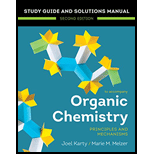
Concept explainers
(a)
Interpretation:
The mechanism with appropriate arrows showing the conversion of intermediate A to B through two
Concept introduction:
Carbocation intermediate can rearrange to become more stable via two possible rearrangements,
(b)
Interpretation:
The mechanism with appropriate curved arrows showing the conversion of intermediate B to Lanosterol is to be drawn.
Concept introduction:
The Carbocation intermediate rearrangement is followed by electrophilic elimination resulting in the formation of C=C bond.
Two curved arrows are needed to show electrophilic elimination. The first curved arrow originates from the base to the electrophile, and the second arrow is drawn from the electrophile to the mid of the C-C bond where C=C bond is formed.
Want to see the full answer?
Check out a sample textbook solution
Chapter 8 Solutions
EBK ORGANIC CHEMISTRY: PRINCIPLES AND M
- Identify A and B in the following reaction sequence. Label each process asconrotatory or disrotatory.arrow_forwardEach of the three molecules shown here contains an OHgroup, but one molecule acts as a base, one as an acid, andthe third is neither acid nor base. (a) Which one acts as abase? (b) Which one acts as an acid? (c) Which one is neitheracidic nor basicarrow_forwardDraw a curved arrow mechanism for the following acid-catalyzed isomerization reaction. Draw three intermediate structures and provide curved arrows. Use the spaces provided.arrow_forward
- Determine if CH3CH2ONa is a suitable reagent to deprotonate the following compound. Explain why. Draw the complete reaction, including the curved arrow mechanism.arrow_forwardIdentify the intermediates (A-D) in the following reaction sequence.arrow_forward(a) Add curved arrows for each step to show how A is converted to theepoxy ketone C. (b) Classify the conversion of A to C as a substitution,elimination, or addition. (c) Draw one additional resonance structure forB.arrow_forward
- Draw structures for A, B, and C in the following reaction sequence and identify the process that converts B to C.arrow_forward(a) Draw a stepwise mechanism for the conversion of A to B. (b) What product would be formed if C was exposed to similar reaction conditions?arrow_forwardDraw the reactant of the following reaction sequence.arrow_forward
- (a) Propose a mechanism for reaction A, which is a substitution reaction. (b) Explain why reaction B does not lead to a similar substitution.arrow_forwardDraw compounds a, b, and c.arrow_forwardUsing ChemDraw Draw a mechanism of a reversible reaction of acetophenone and strong acid (H-A) to form a protonated acetophenone and a weak base. Draw all the electron pairs of the molecules and the arrows.arrow_forward
 ChemistryChemistryISBN:9781305957404Author:Steven S. Zumdahl, Susan A. Zumdahl, Donald J. DeCostePublisher:Cengage Learning
ChemistryChemistryISBN:9781305957404Author:Steven S. Zumdahl, Susan A. Zumdahl, Donald J. DeCostePublisher:Cengage Learning ChemistryChemistryISBN:9781259911156Author:Raymond Chang Dr., Jason Overby ProfessorPublisher:McGraw-Hill Education
ChemistryChemistryISBN:9781259911156Author:Raymond Chang Dr., Jason Overby ProfessorPublisher:McGraw-Hill Education Principles of Instrumental AnalysisChemistryISBN:9781305577213Author:Douglas A. Skoog, F. James Holler, Stanley R. CrouchPublisher:Cengage Learning
Principles of Instrumental AnalysisChemistryISBN:9781305577213Author:Douglas A. Skoog, F. James Holler, Stanley R. CrouchPublisher:Cengage Learning Organic ChemistryChemistryISBN:9780078021558Author:Janice Gorzynski Smith Dr.Publisher:McGraw-Hill Education
Organic ChemistryChemistryISBN:9780078021558Author:Janice Gorzynski Smith Dr.Publisher:McGraw-Hill Education Chemistry: Principles and ReactionsChemistryISBN:9781305079373Author:William L. Masterton, Cecile N. HurleyPublisher:Cengage Learning
Chemistry: Principles and ReactionsChemistryISBN:9781305079373Author:William L. Masterton, Cecile N. HurleyPublisher:Cengage Learning Elementary Principles of Chemical Processes, Bind...ChemistryISBN:9781118431221Author:Richard M. Felder, Ronald W. Rousseau, Lisa G. BullardPublisher:WILEY
Elementary Principles of Chemical Processes, Bind...ChemistryISBN:9781118431221Author:Richard M. Felder, Ronald W. Rousseau, Lisa G. BullardPublisher:WILEY





